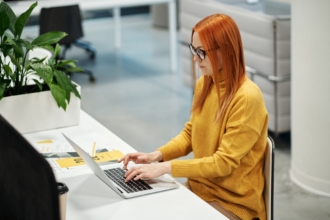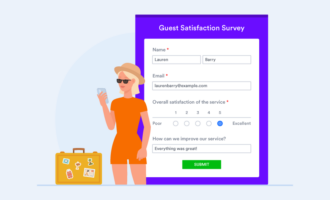Business leaders are like ship captains. If they’re not steering the company in the right direction, it isn’t likely to reach its desired destination.
While many people believe they should be in leadership positions, only 10 percent of people are, in fact, naturally good at leading others, while another 20 percent show some management talent that can develop into leadership qualities.
To ensure your company is in the right hands, it’s wise to conduct leadership surveys on a regular basis. Surveys can help you determine whether you have the right leaders in place and how employees perceive them.
In this article, we’ll look at the benefits of conducting leadership surveys, offer tips for creating effective leadership surveys, and provide examples of leadership survey questions you can use. Finally, we’ll show you a tool that makes surveying a snap.
The benefits of using leadership survey questions
One of the best ways for an organization to determine whether it’s successfully meeting its goals is to ask for feedback from relevant stakeholders. In the case of leadership, the stakeholders are individuals in two parties: the leaders themselves, which could be one person or multiple people, and the employees who work under them.
Organizations can use leadership surveys with both types of stakeholders to gather critical feedback regarding performance, perception, outcomes, and other factors.
One of the biggest advantages surveys offer is anonymity. While some organizations don’t anonymize surveys, others do because it provides a sense of security for respondents and increases the likelihood they’ll be honest and transparent.
When organizations ask people to give feedback in person or to identify themselves during a survey, they may be concerned about facing repercussions for negative feedback. In an anonymous survey, they can offer the truth — without worrying that it may affect their job.
Surveys also provide organizations with the ability to gather data from a large group of people in a short amount of time. Compared to interviews, for example, leadership surveys take only a few minutes to complete, while face-to-face conversations take much longer.
In addition, survey software can assist the company in organizing that data into insight to make actionable changes. For example, if the majority of people say that leaders don’t provide regular performance updates about the company, the organization can use that information to create a process for sending out quarterly newsletters.
Tips for creating an effective leadership survey
Creating a survey is part art and part science. You have to use the right type of question formats, ensure the phrasing of the questions is clear, and put the questions in the right order. Follow these best practices to conduct a comprehensive and informative leadership survey:
- Have a clear goal. Determine specifically what you want to know. For example, are you trying to assess the leader’s overall performance? Are you interested in learning about the effectiveness of their communication style or whether they’re an inspirational leader?
- Cater to one audience at a time. Your leadership survey should speak to one audience, such as the leaders themselves or the employees. Avoid using the same questions for multiple audiences, as they may not be relevant or provide you with useful insights.
- Determine mandatory and optional questions. Figure out which questions you specifically need answers for and which questions are nice to have. This way, you can reduce survey fatigue, since some people may not want to respond to every question in the survey.
- Use branching logic. Ensuring leadership questions are relevant to the audience is key to getting high-quality survey responses. Branching or conditional logic serves up relevant questions based on the answers the responder has provided to previous questions.
- Have a plan for analyzing responses. If you don’t do anything with the data you’ve gathered, your respondents may not be willing to complete another survey in the future. Have a process for analyzing the data and turning it into an action plan for the organization.
Examples of leadership survey questions
Self-assessment questions
Self-assessment questions enable organizations to determine how the leader feels about their own performance. This is a good way to see whether the leader’s perception of themselves matches others’ perceptions.
- Have you met your own expectations this fiscal year? If the answer for this question differs greatly from the leader’s actual performance, the organization may need to provide some additional training.
- How do you help others achieve their goals? Leaders need to know how to support their team through training and development, mentorship, coaching, and additional resources.
- How well do you handle criticism of your skills and performance? Not everyone can take constructive criticism. It requires humility to accept it and learn from it.
- Do you take responsibility for your team when they don’t meet their targets? If a leader takes credit for their teams’ successes but not their shortfalls, this can lead to distrust among team members and impact their loyalty to the leader.
- How do you inspire your team to meet company goals? Part of the leader’s role is to motivate their employees to do their best work, whether it’s through coaching sessions, motivational speeches, competitive examples, rewards, or something else.
Feedback questions
These questions are for employees and may focus on specific aspects of the leader’s performance as well as their skills, such as communication or negotiation.
- How would you rate the leadership team’s performance this fiscal year? It’s important to know the overall sentiment of the employees in regard to the leadership at the company. Whether it’s negative or positive, this information can help you determine if you need to make any changes or continue with certain elements.
- What are the biggest leadership gaps you see in the organization? Employees may provide insight the executive team is unaware of, such as specific skills the leaders lack or projects they need to be more aware of.
- Do you feel inspired by the leadership team? If the leadership team seems lackluster, uninterested, or unapproachable, employees may not feel motivated to perform at their highest level.
- Do you have an opportunity to share ideas and feedback with the leadership team? It’s important for leaders to have a process in place where employees feel comfortable sharing ideas, feedback, and suggestions for improvement — without any negative repercussions.
- If you were in a leadership role in the company, what would be your first task? This question can help the organization determine employees’ priorities. If this list differs greatly from what leaders prioritize, there may be a bigger issue that needs addressing.
The benefits of delivering leadership survey questions with Jotform
Jotform is an excellent tool for organizations that want to gain critical feedback from their leadership team as well as their employees. This survey software is ideal for asking leadership survey questions and managing many other business-critical processes.
Jotform comes with ready-to-use leadership survey templates, including a leadership skills survey, health and safety skills survey, evaluation form, self-assessment survey, and leadership feedback form. Each template is easy to customize, so you can change the text, structure, or visuals of the form in just minutes and then distribute the surveys via email or QR code.
All survey responses collected through Jotform are highly secure, so you don’t need to worry about confidential information getting into the wrong hands. You can also use Jotform Report Builder to convert survey responses into actionable insights that will improve your organization’s leadership.
Get started building your own leadership survey now — simply sign up for a Jotform account, choose your template, and begin crafting your questions.
Photo by Memento Media on Unsplash






































































































Send Comment: